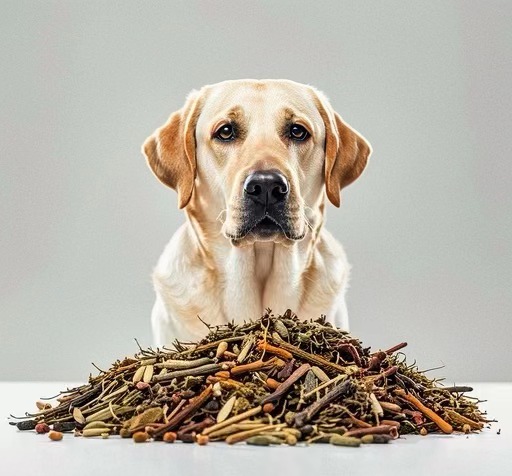
by TCMVET | Feb 24, 2024 | Dog Cancer & Tumors
Title: “Harnessing Ancient Wisdom for Modern Health: The Role of Traditional Chinese Herbal Medicine in Treating Canine Hepatocellular Carcinoma”
In the realm of veterinary medicine, the integration of conventional treatments with traditional practices, such as Chinese herbal medicine, is an emerging trend offering new hope to canine patients suffering from serious conditions like hepatocellular carcinoma (HCC). This article delves into the innovative approach of combining traditional Chinese herbal remedies with modern veterinary practices to treat HCC in dogs.
Understanding Hepatocellular Carcinoma in Dogs
Hepatocellular carcinoma, a malignant tumor affecting the liver’s epithelial tissue, is a significant health concern in canines. Accounting for about half of all liver cancers in dogs, HCC presents symptoms such as loss of appetite, weakness, diarrhea, weight loss, enlarged liver, and vomiting. While the exact causes remain unclear, environmental factors, diet, toxins, and genetic predisposition are believed to play crucial roles.
Traditional Chinese Herbal Medicine: An Overview
Chinese herbal medicine, a cornerstone of Traditional Chinese Medicine (TCM), has been used for thousands of years to treat various ailments in humans and animals. This practice involves using specific herbs and natural substances, often in combination, to restore balance and health. The philosophy behind TCM is to treat the whole patient, not just the symptoms, which aligns well with holistic veterinary practices.
Integrating Chinese Herbs into Canine Cancer Treatment
The integration of Chinese herbal medicine into canine cancer treatment is based on the principle of using natural compounds to support the body’s healing processes. These herbs are believed to possess properties that can help detoxify the body, strengthen the immune system, and improve overall health. For dogs with HCC, certain herbs may target liver health specifically, aiding in the reduction of tumor growth and alleviating symptoms.
Potential Benefits and Considerations
The potential benefits of using Chinese herbs in treating HCC in dogs include:
- Enhanced Quality of Life: By reducing symptoms and improving general well-being, these herbs can enhance the quality of life for canine patients.
- Complementary Treatment: Used alongside conventional treatments like chemotherapy, Chinese herbs may enhance efficacy and reduce side effects.
- Holistic Approach: This method considers the dog’s overall health, leading to a more comprehensive treatment strategy.
However, it’s crucial for pet owners to consult with a veterinarian experienced in both conventional and herbal medicine. The correct dosage and formulation of herbs are vital, and professional guidance is necessary to avoid any potential interactions with other treatments.
Real-World Applications and Case Studies
Several case studies and anecdotal reports suggest the effectiveness of Chinese herbal medicine in managing canine HCC. Veterinarians who practice integrative medicine have observed improvements in liver function, reduced tumor sizes, and extended survival times in dogs treated with these herbs.
The integration of traditional Chinese herbal medicine into the treatment of canine hepatocellular carcinoma represents a convergence of ancient wisdom and modern science. It offers a promising complementary approach that may improve outcomes and quality of life for our canine companions battling liver cancer. As with any medical treatment, it’s essential to proceed under the guidance of a qualified veterinarian, ensuring the safest and most effective care for your pet.

by TCMVET | Feb 22, 2024 | Dog Cancer & Tumors
The field of veterinary oncology is increasingly embracing integrative approaches, combining conventional Western treatments with traditional Eastern therapies like Chinese herbal medicine. This integration aims to enhance the efficacy of treatments, particularly in challenging cases like canine pancreatic cancer. This article delves into the role of Chinese herbal treatments in canine pancreatic cancer, evaluating their efficacy and potential benefits as part of an integrative oncology approach.
Understanding Canine Pancreatic Cancer: Pancreatic cancer in dogs is a serious and often aggressive disease, characterized by the rapid growth of malignant tumors in the pancreas. Symptoms may include loss of appetite, weight loss, vomiting, and lethargy. Conventional treatments typically involve surgery, chemotherapy, and radiation, but these can have limited success and significant side effects.
The Rise of Integrative Oncology in Veterinary Medicine: Integrative oncology combines traditional veterinary treatments with complementary therapies like Chinese herbal medicine. This approach aims to provide a more holistic treatment, focusing on the overall well-being of the pet, not just the cancer itself. It’s gaining popularity as pet owners and veterinarians seek out more comprehensive treatment options.
Chinese Herbal Medicine in Canine Pancreatic Cancer: Chinese herbal medicine has been used for centuries in human medicine and is now finding its place in veterinary care. These herbs are believed to possess properties that can help fight cancer, boost the immune system, and improve quality of life. Key herbs used include Huang Qi (Astragalus), which is known for its immune-boosting properties, and Bai Hua She She Cao (Hedyotis diffusa), reputed for its anti-tumor effects.
Evaluating the Efficacy of Chinese Herbal Treatments: Several studies and anecdotal evidence suggest that Chinese herbal treatments can be beneficial in managing canine pancreatic cancer. These benefits may include slowed tumor growth, reduced side effects from conventional treatments, and improved overall quality of life. However, it is important to note that the efficacy of these treatments can vary and more scientific research is needed to fully understand their benefits and limitations.
Integrating Chinese Herbal Medicine with Conventional Treatments: In integrative oncology, Chinese herbal treatments are used in conjunction with conventional therapies. This approach aims to enhance the effectiveness of standard treatments, manage side effects, and maintain the pet’s quality of life. It’s important that this integration is overseen by a veterinarian skilled in both conventional and herbal medicine.
Integrative oncology represents a significant advancement in the treatment of canine pancreatic cancer, offering a more comprehensive approach to care. The use of Chinese herbal treatments as part of this approach shows promise in enhancing treatment efficacy and improving the quality of life for dogs with this challenging disease. As research in this area continues to grow, it will provide a deeper understanding of the role and benefits of these traditional remedies in veterinary medicine.

by TCMVET | Feb 22, 2024 | Dog Cancer & Tumors
The field of veterinary oncology is witnessing a paradigm shift with the integration of Traditional Chinese Medicine (TCM), particularly Chinese herbal medicine, in treating various forms of cancer. One area where this approach shows significant promise is in combating aggressive pancreatic neoplasms in dogs. This article explores the potential of Chinese herbal medicine in revolutionizing canine cancer care, offering new hope and avenues for treatment.
Understanding Aggressive Pancreatic Neoplasms in Dogs: Pancreatic neoplasms, or tumors, in dogs can be highly aggressive and often fatal. These tumors are notorious for their rapid growth and the high potential for metastasis. Symptoms may include abdominal pain, weight loss, lethargy, and in more advanced cases, jaundice. Traditional treatment options, such as surgery, chemotherapy, and radiation, offer limited success and can be associated with significant side effects.
The Emergence of Chinese Herbal Medicine in Canine Oncology: Chinese herbal medicine, a key component of TCM, has been used for centuries to treat a variety of ailments in humans. Its principles are now being applied to veterinary medicine, focusing on restoring balance in the body and enhancing natural healing processes. In the context of canine pancreatic cancer, these herbs are believed to help inhibit tumor growth, reduce inflammation, and boost the immune system.
Key Chinese Herbs and Their Potential Benefits: Herbs such as Huang Qi (Astragalus), Bai Hua She She Cao (Hedyotis diffusa), and Ban Zhi Lian (Scutellaria barbata) are known for their anti-cancer properties. Turmeric, with its active compound curcumin, is recognized for its anti-inflammatory and anti-oxidant effects, which may be beneficial in cancer care. These herbs are thought to target the cancer cells while minimizing damage to healthy cells, a significant advantage over conventional therapies.
Integrating Chinese Herbal Medicine with Conventional Treatments: The integration of Chinese herbal medicine into the treatment plan for canine pancreatic cancer involves a synergistic approach. The aim is to use these herbs alongside conventional treatments to enhance their effectiveness, mitigate side effects, and improve the overall quality of life of the affected dogs. This integrative approach is tailored to each individual dog’s condition and requires the guidance of a veterinarian skilled in both herbal and conventional oncology.
Clinical Evidence and Research: While the research on Chinese herbal medicine in veterinary oncology is still in its nascent stages, several studies and anecdotal evidence have shown positive outcomes. Dogs treated with a combination of Chinese herbs and conventional therapies have shown improvements in symptoms, slowed tumor growth, and, in some cases, extended survival times. However, more extensive and controlled studies are needed to fully substantiate these findings.
The potential of Chinese herbal medicine in treating aggressive pancreatic neoplasms in dogs represents a significant advance in canine cancer care. This approach not only offers an alternative to conventional treatments but also a more holistic path to managing cancer. For pet owners interested in exploring this option, it is crucial to consult with a veterinarian experienced in integrative medicine to ensure the best possible outcome for their furry companions.

by TCMVET | Feb 22, 2024 | Dog Cancer & Tumors
In the realm of veterinary medicine, the battle against canine pancreatic cancer poses significant challenges due to the aggressive nature of the disease. However, the integration of ancient practices with modern science is opening new frontiers in treatment options. This article explores the role of Chinese herbs in combating canine pancreatic cancer, highlighting how these time-honored remedies are being used to address modern veterinary challenges.
Understanding Canine Pancreatic Cancer: Pancreatic cancer in dogs is a serious condition characterized by the growth of malignant tumors in the pancreas. This type of cancer is particularly aggressive and often diagnosed in advanced stages. Symptoms may include loss of appetite, weight loss, lethargy, and abdominal pain. While traditional treatments such as surgery, chemotherapy, and radiation are available, their effectiveness can be limited, and they often come with significant side effects.
The Emergence of Chinese Herbal Medicine in Veterinary Oncology: Chinese Herbal Medicine (CHM), a key component of Traditional Chinese Medicine (TCM), has been practiced for thousands of years. In recent times, its application in veterinary oncology has gained attention as a complementary approach to conventional cancer treatments. CHM is based on the concept of balancing the body’s energy, or Qi, and focuses on enhancing the body’s natural healing abilities.
Key Chinese Herbs and Their Benefits: Some of the herbs commonly used in TCM for cancer treatment include:
- Huang Qi (Astragalus): Known for its immune-boosting and anti-tumor properties.
- Bai Hua She She Cao (Hedyotis diffusa): Believed to possess anti-cancer effects.
- Ling Zhi (Reishi Mushroom): Used for its potential to enhance the immune system and inhibit tumor growth.
- Jiaogulan (Gynostemma): Recognized for its antioxidant properties and ability to protect cells.
Integrating Chinese Herbs with Conventional Cancer Treatments: Integrating CHM with conventional treatments offers a holistic approach to canine pancreatic cancer care. This integration aims to enhance the effectiveness of traditional treatments, reduce side effects, and improve the overall quality of life for dogs undergoing cancer therapy. It is crucial that such integrative treatments are conducted under the guidance of veterinarians who are experienced in both CHM and conventional oncology.
Clinical Evidence and Research: While research on CHM in veterinary oncology is still in its nascent stages, several studies and anecdotal evidence suggest that dogs treated with CHM in conjunction with conventional therapies show improvements in quality of life and, in some cases, slower disease progression. Further research and clinical trials are needed to establish standardized treatment protocols and fully understand the efficacy of CHM in treating canine pancreatic cancer.
The use of Chinese herbs in the fight against canine pancreatic cancer represents a unique blend of ancient wisdom and modern medical practices. This integrative approach not only offers hope for better management of this challenging disease but also underscores the potential of holistic treatments in veterinary medicine. Pet owners considering this approach should consult with veterinarians skilled in both traditional and herbal medicine to ensure the best possible care for their pets.

by TCMVET | Feb 22, 2024 | Dog Cancer & Tumors
Canine pancreatic cancer, a complex and often aggressive disease, not only challenges the health of our beloved pets but also leads to debilitating symptoms like weakness. In an innovative approach to veterinary care, the use of Chinese herbal remedies is emerging as a promising method to address these challenges. This article explores the integration of traditional Chinese herbal medicine in alleviating the weakness associated with canine pancreatic cancer, marking a blend of tradition and innovation in veterinary practice.
Understanding Canine Pancreatic Cancer: Pancreatic cancer in dogs is characterized by the growth of malignant tumors in the pancreas. This condition can lead to a multitude of symptoms, including severe weakness, loss of appetite, weight loss, and digestive problems. Traditional Western treatments typically focus on surgery, chemotherapy, or radiation therapy, but these can often be harsh and may not adequately address all the symptoms, particularly the pervasive weakness that affects the quality of life of the canine patients.
The Role of Chinese Herbal Medicine: Traditional Chinese Medicine (TCM) has been utilized for centuries to treat various ailments in humans, and its principles are now being applied in veterinary medicine. TCM focuses on restoring the balance of Qi (vital energy) in the body and boosting the body’s natural healing capabilities. In the context of canine pancreatic cancer, Chinese herbal remedies are employed to strengthen the body, enhance energy levels, and alleviate symptoms like weakness.
Key Chinese Herbs Used in Treatment: Herbs such as Ren Shen (Ginseng), known for boosting energy and vitality, and Huang Qi (Astragalus), renowned for its immune-enhancing properties, are commonly used in treating weakness in dogs with cancer. Other herbs like Dang Gui (Angelica Sinensis) and Bai Zhu (Atractylodes) are used for their nourishing and strengthening effects. It is important to note that these herbs should be administered under the guidance of a veterinarian experienced in herbal medicine.
Integrating Chinese Herbs with Conventional Treatments: The integration of Chinese herbal remedies with conventional cancer treatments offers a comprehensive approach to managing canine pancreatic cancer. This holistic strategy aims not only to treat the cancer but also to mitigate the side effects of conventional treatments and address symptoms like weakness. The goal is to improve the overall well-being and quality of life of dogs undergoing cancer treatment.
Clinical Evidence and Research: While the field of integrating Chinese herbal medicine into veterinary oncology is still growing, several case studies and anecdotal evidence suggest that dogs receiving herbal treatments in conjunction with conventional therapies exhibit less weakness and better overall health. However, more scientific research is necessary to fully understand the efficacy and optimal use of these herbal remedies in treating canine pancreatic cancer.
The use of Chinese herbal remedies in treating the weakness caused by canine pancreatic cancer represents a significant step from tradition to innovation in veterinary medicine. This approach not only offers a nod to ancient healing practices but also opens new avenues in comprehensive, holistic animal healthcare. For pet owners exploring this option, consulting with a veterinarian skilled in both conventional and herbal medicine is crucial to ensure the best care for their furry companions.

by TCMVET | Feb 22, 2024 | Dog Cancer & Tumors
Canine pancreatic cancer, a formidable health challenge for dogs, often presents a grim prognosis. However, the evolving field of veterinary medicine is constantly exploring new treatment avenues. One such promising area is the use of Chinese Herbal Medicine (CHM) as a potential means to slow down the progression of this aggressive disease. This article delves into how CHM is being integrated into traditional veterinary practices to offer a ray of hope for dogs battling pancreatic cancer.
Understanding Pancreatic Cancer in Dogs: Pancreatic cancer in dogs is a malignant and aggressive form of cancer that affects the pancreas, an organ critical for digestion and insulin regulation. Symptoms can range from weight loss and loss of appetite to more severe cases of diabetes and liver dysfunction. Traditional treatment options, including surgery, chemotherapy, and radiation, have limited success and can be accompanied by significant side effects.
The Role of Chinese Herbal Medicine: CHM has been used for centuries in human medicine and is gaining traction in veterinary practices for its holistic approach to disease management. In the context of canine pancreatic cancer, CHM is viewed not as a cure but as a complementary therapy that can potentially slow the progression of the disease and improve the quality of life for affected dogs.
Key Chinese Herbs and Their Potential Benefits: Several herbs are commonly used in CHM for cancer treatment, including:
- Huang Qi (Astragalus): Known for its immune-boosting properties.
- Bai Hua She She Cao (Hedyotis diffusa): Believed to have anti-tumor effects.
- Lingzhi (Reishi Mushroom): Used for its potential to inhibit tumor growth and boost immune response.
- Jiaogulan (Gynostemma): Possesses antioxidant properties and may aid in protecting against cellular damage.
It’s crucial to note that these herbs should only be administered under the guidance of a veterinarian experienced in both CHM and conventional oncology.
Integrating CHM with Conventional Treatments: The integration of CHM into a canine pancreatic cancer treatment plan is a balancing act. The approach involves using these herbs alongside conventional treatments like chemotherapy, with the aim of enhancing the efficacy of these treatments, reducing side effects, and improving overall well-being.
Clinical Evidence and Research: Research into the efficacy of CHM in treating canine pancreatic cancer is ongoing. While anecdotal evidence and preliminary studies have shown encouraging results in slowing disease progression and improving quality of life, more extensive, controlled studies are needed to establish definitive benefits and treatment protocols.
The integration of Chinese Herbal Medicine into the treatment regimen for canine pancreatic cancer represents a promising development in veterinary oncology. By offering a complementary approach that focuses on the overall health and well-being of the dog, CHM provides a more holistic treatment option. For pet owners considering this approach, it is essential to consult with a veterinarian skilled in integrative medicine to ensure a safe and tailored treatment plan for their pet.







